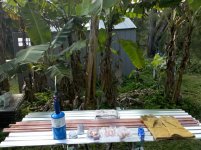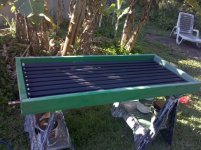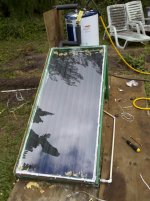AM, I don't know the different properties of water heated in steel to be able to say how safe it would be, but I see no reason why it wouldn't work to heat the water. To be on the safe side, I wouldn't drink from it, like you mentioned. I think it might depend on how much larger a diameter you are talking about. If it is too much larger, it might not heat all the water as efficiently and you might have to scale up the heat collector size compared to the formula that I used. In essence you will have less surface area on the water compared to the volume of water for heating. But I would bet if you put a steel pipe painted black out in the sun at your house it would get hot as hell by the end of the day. So you would get solar heating with it. You will need a bunch of T connectors and 2 90 degree elbow connectors for whatever pipe you decide on using. I put the glass sheet on after testing it for a day. I wanted to check for leaks before I sealed on the glass. It still got really hot without the glass sheet. I couldn't hold my hand on the copper pipes for more than a second before having to yank it away from the heat. The glass just intensifies the heat, keeps it from escaping back out. I think that you could build a system without the glass, but again, you might need to up size it a bit to compensate for a little less efficiency. One of my goals for building this was to try and upcycle as much used material as possible for this project. Unfortunately, I didn't have a lot of time on this trip, and she didn't gather as much supplies as I had hoped. I wanted her to start sourcing glass panels, used sliding glass doors, or large windows. She said that her friend had a bunch, but he flaked out on me and we ended up having to buy because I didn't have time to wait. I'm sure YOU will have no problem finding a used piece of glass. One thing that I did find from this project is the glass is almost the most critical piece when it comes to sizing. If you can find a piece for free, try to size your collector to that piece. To buy the glass and have it cut was over $100. That was a killing point for me in this project since I was trying to keep it low cost with upcycled materials. The original design was to use 2 pieces of glass, make it double pane. I think that would make it even more efficient, but I had decided that this would not be necessary in Hawaii and went with the single pane. I think for most the year this would also be the case in Arizona, but maybe the double might be worth it in the winter time. In other areas of the country, I would definitely suggest the double pane. It just wasn't worth the extra work to make it double in Hawaii with my limited time. I personally think the acrylic should work, just don't know about the scratched up pieces. I guess it depends how scratched up they are. The scratches have a potential of blocking some of the sun from coming through. But I have a friend who lives next to a golf course who wants me to help him get some alternative energy stuff going at his house. And my idea was to build one of these with an acrylic top to protect it from errant golf balls that constantly fly into his yard. A mirror would definitely help to concentrate the sun rays onto the collector, but you would just have to figure out an angle that reflected onto the collector without blocking the sun at some other point of the day.





